#persian army
Photo
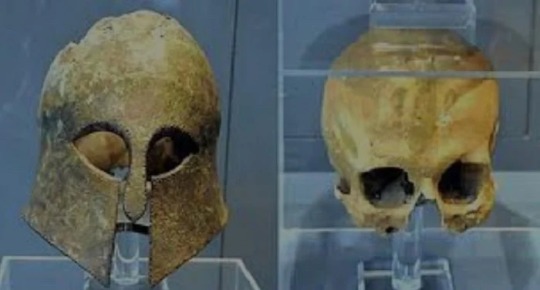
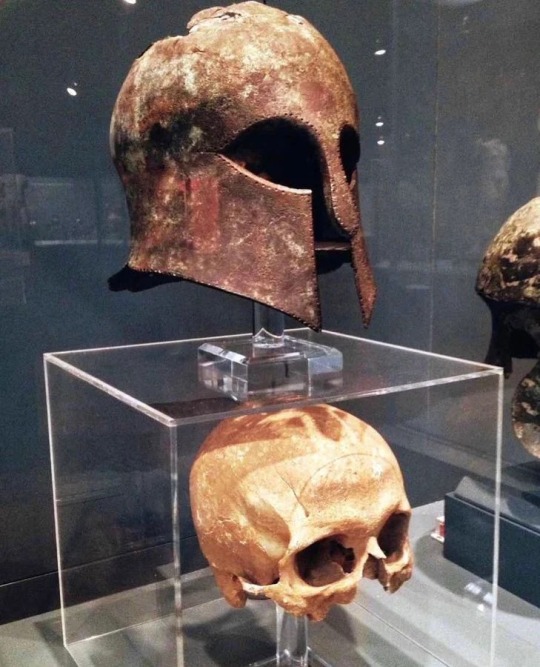
Battle of Marathon: The Helmet With the Soldier’s Skull Still Inside
This remarkable Corinthian-style helmet from the Battle of Marathon was reputedly found in 1834 with a human skull still inside.
It now forms part of the Royal Ontario Museum’s collections, but originally it was discovered by George Nugent-Grenville, who was the British High Commissioner of the Ionian Islands between 1832-35.
A keen antiquarian, Nugent-Grenville carried out a number of rudimentary archaeological excavations in Greece, one of which took place on the Plains of Marathon, where the helmet was uncovered.
A pivotal moment in Ancient Greek history, the battle of Marathon saw a smaller Greek force, mainly made up of Athenian troops, defeat an invading Persian army.
There were numerous casualties, and it appears that this helmet belonged to a Greek hoplite (soldier) who died during the fighting of the fierce and bloody battle.
The Athenian army under General Miltiades consisted almost entirely of hoplites in bronze armor, using primarily spears and large bronze shields. They fought in tight formations called phalanxes and literally slaughtered the lightly-clad Persian infantry in close combat.
The hoplite style of fighting would go on to epitomize ancient Greek warfare.
Today the helmet and associated skull can be viewed at the Royal Ontario Museum’s Gallery of Greece.
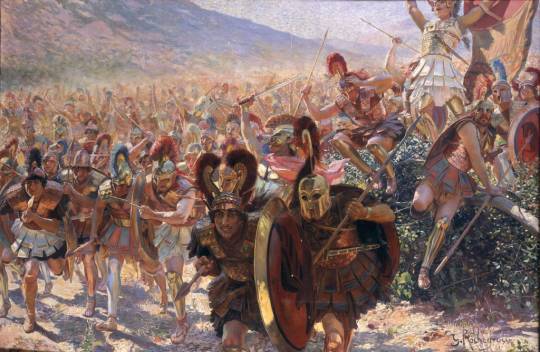
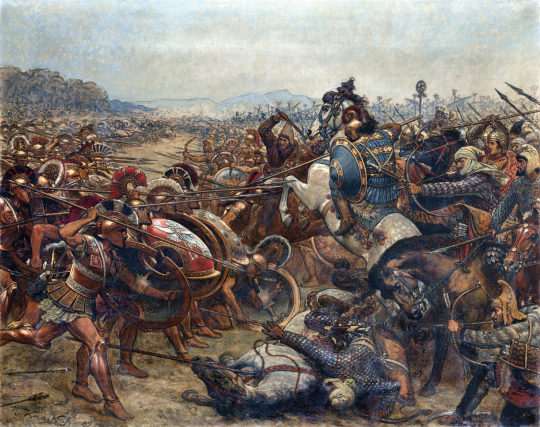

Battle of Marathon saved Western Civilization
It was in September of the year 490 BC when, just 42 kilometers (26 miles) outside of Athens, a vastly outnumbered army of brave soldiers saved their city from the invading Persian army in the Battle of Marathon.
But as the course of history shows, in the Battle of Marathon, they saved more than just their own city: they saved Athenian democracy itself, and consequently, protected the course of Western civilization.
According to historian Richard Billows and his well-researched book Marathon: How One Battle Changed Western Civilization, in one single day in 490 BC, the Athenian army under General Miltiades changed the course of civilization.
It is very unlikely that world civilization would be the same today if the Persians had defeated the Athenians at Marathon. The mighty army of Darius I would have conquered Athens and established Persian rule there, putting an end to the newborn Athenian democracy of Pericles.
In effect, this would certainly have destroyed the idea of democracy as it had developed in Athens at the time.
The Battle of Marathon lasted only two hours, ending with the Persian army breaking in panic toward their ships with the Athenians continuing to slay them as they fled.
In his book, however, Billows calls the Battle of Marathon a “miraculous victory” for the Greeks. The victory was not as easy as it is often portrayed by many historians. After all, the Persian army had never before been defeated.
By Tasos Kokkinidis.


#Battle of Marathon: The Helmet With the Soldier’s Skull Still Inside#greek helmet#persian army#general miltiades#king darius i#ancient artifacts#archeology#archeolgst#history#history news#ancient history#ancient culture#ancient civilizations#ancient greece#greek history#long reads
87 notes
·
View notes
Link
Gaugamela - The Battle That Changed The World
0 notes
Link
Gaugamela - The Battle That Changed The World
1 note
·
View note
Text

doodling al'skander when i should be sleeping because i have not recovered from the effects of the persian boy
#completely obsessed with the whole lover (hephaistion/macedon) vs beloved (bagoas/persia) dichotomy#and all the implications of that#alexander as courtesan to the macedonian army!!#anyway. started reading funeral games today so just having lots of thoughts at the moment#the persian boy#mary renault#my art#alexander the great
103 notes
·
View notes
Text
Do you ever just get hit in the face with a visceral memory that almost feel like you relived it for a second?
Edit:
Holy shit, I just found exactly one of the ones I had as a kid!!!
Edit 2:
Holy shit again they also have all of the other ones I had!!! ;-;
Maybe I'll buy them again? Actually relive my childhood?
#just got hit in the face with the memory of being like 10(?) and having like some little minis that were madd for wargames#but i didnt play them i just liked having a little army of greek hoplites and chariots and shit#i also had some persians and romans too#also had some like papercraft castles and stuff that were really cool#i wish i had those again
3 notes
·
View notes
Text
The first Persian Empire, called the Achaemenid Empire, is known for having an elite force of soldiers. Named the “Immortals” by Herodotus, this army consisted of a heavy infantry of 10,000 men, that never reduced in number or strength.
37 notes
·
View notes
Text
Guess who they are?
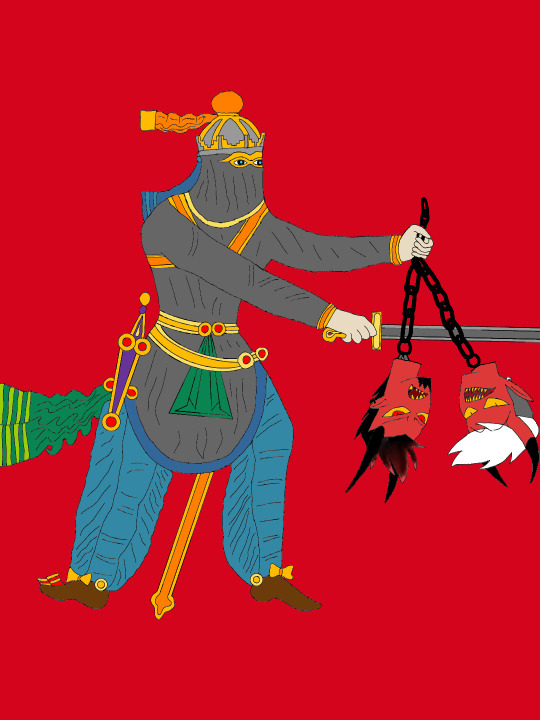
#hazbin hotel#stolas#loona helluva boss#helluva boss#sassanid empire#hazbin hotel alastor and charlie#charlie#alastor#fizzaroli helluva boss#helluva boss ozzie#mallie#moxxie#first shapur#sassanid army#sassanid#persian
2 notes
·
View notes
Text
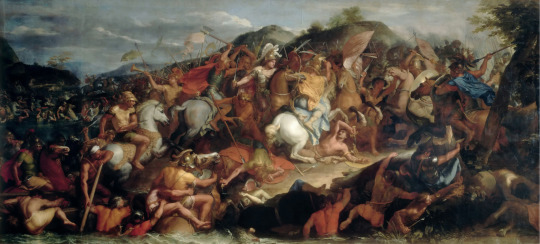

The Battle of the Granicus by Charles Le Brun - depicts Alexander the Great at the centre of the cavalry battle.
Spithridates, the Persian satrap of Ionia and Lydia, was about to attack Alexander from behind with his sword, but his sword arm was cut off by Cleitus the Black.
#alexander the great#alexander#battle of the granicus#charles le brun#art#painting#history#europe#european#macedonian#army#persian#ancient#greek#greece#macedonia#macedon#cavalry#battle#cleitus#cleitus the black#spithridates#achaemenid empire#hellenic league#asia minor#satraps
13 notes
·
View notes
Text
Ive been reading the Persian Boy and I'm not suprised by the orientalism but I am disappointed
#Cipher talk#Tbc I don't mean the depiction of slavery#It's very specifically the depiction of Greek culture- I've gotten to the scene where Baogas has spears thrown at him by the 'squires'- as#Subtly 'better' than Persian culture#There's a scrap of deniability bc it's from Baogas's POV so he thinks the Greeks and Macedonians are completely weird and immodest#But what really gets me is how it portrays Alexander as outraged by the treatment of Greeks held in slavery and how it's all 'oh in Greece#They Never cut a boy' and there's no mention that Athenian 'democracy' had a large class of slaves as of yet#But even as we're told by the narrator how improper and immodest the Greeks and Macedonians are I can feel the author winking and nudging#Like 'oh look at how the Persian court is weighed down by ceremony its barely a real army they're decadent (in the way a conservative says#That about a culture) and look at how Baogas holds rivers as sacred and doesn't swim in them (you know the same water he gets sick from)#And the hypocrisy that he was groomed as a 'courtesan' as a literal child but is embarrassed by nudity'#Yeah Mary I can see the feelings of cultural superiority. I still remember that Athens was misogynistic as fuck and had plenty of issues
3 notes
·
View notes
Link
n this documentary episode we explore the Greco-Persian wars to understand why the Persians failed to conquer Greece. The video begins with a historical overview of the Achaemenid Persian Empire and then an analysis of the Ionian Revolt which led to war. We then look at what the Persian army of Darius and Xerxes wished to achieve and see to what extent these objectives were met. This includes looking at the Battle of Marathon, Thermopylae, Salamis, Mykale, and more which featured Greek armies of Athens, Sparta and more.
#grecopersianwars#greco persian wars#greco-persian wars#greece#greek history#persian history#ancient history#Achaemenid Persian Empire#mellothanato#morhistory#morhellenomania#hellenomania#darius#xerxes#greek army#history
6 notes
·
View notes
Text
im just saying. im JUST saying. pokemon aus.
#coordinator dick grayson i am THINKING abt you#also tbh i still see him doing nightwing that's just the kind of guy he is but i want him to be a performer#also i want oswald to have an alolan persian specifically#jonathan with a little poison type team#i am jst#im jst thinkin abt it#carmine raises torchics.....#selina and her army of stray cat pkmn#roy definitely has fire types#vibrates#IF ANYONE IS INTERESTED... HMU
6 notes
·
View notes
Text

Shoulder Sleve Insignia - Former Wartime Service (SSI-FWTS) or what we soldiers called a combat patch. A soldier should hold very few accomplishments above this one.
1 note
·
View note
Link
• U.S. State Department Documents on Iran | 1951-1980
• Iran Oil Consortium | Archive (1953-1954)
#state department#iran#iranian#shah of iran#us foreign policy#middle east#tehran#foreign policy#foreign affairs#military#monarchy#loy henderson#persian#history#cold war#fazlollah zahedi#morale#army#armed forces#1950's#iranian history#us government#soviet union#russia#economy#oil#financial crisis#elections
0 notes
Text
Despite Sparta’s reputation for superior fighting, Spartan armies were as likely to lose battles as to win them, especially against peer opponents such as other Greek city-states. Sparta defeated Athens in the Peloponnesian War—but only by accepting Persian money to do it, reopening the door to Persian influence in the Aegean, which Greek victories at Plataea and Salamis nearly a century early had closed. Famous Spartan victories at Plataea and Mantinea were matched by consequential defeats at Pylos, Arginusae, and ultimately Leuctra. That last defeat at Leuctra, delivered by Thebes a mere 33 years after Sparta’s triumph over Athens, broke the back of Spartan power permanently, reducing Sparta to the status of a second-class power from which it never recovered.
Sparta was one of the largest Greek city-states in the classical period, yet it struggled to achieve meaningful political objectives; the result of Spartan arms abroad was mostly failure. Sparta was particularly poor at logistics; while Athens could maintain armies across the Eastern Mediterranean, Sparta repeatedly struggled to keep an army in the field even within Greece. Indeed, Sparta spent the entirety of the initial phase of the Peloponnesian War, the Archidamian War (431-421 B.C.), failing to solve the basic logistical problem of operating long term in Attica, less than 150 miles overland from Sparta and just a few days on foot from the nearest friendly major port and market, Corinth.
The Spartans were at best tactically and strategically uncreative. Tactically, Sparta employed the phalanx, a close-order shield and spear formation. But while elements of the hoplite phalanx are often presented in popular culture as uniquely Spartan, the formation and its equipment were common among the Greeks from at least the early fifth century, if not earlier. And beyond the phalanx, the Spartans were not innovators, slow to experiment with new tactics, combined arms, and naval operations. Instead, Spartan leaders consistently tried to solve their military problems with pitched hoplite battles. Spartan efforts to compel friendship by hoplite battle were particularly unsuccessful, as with the failed Spartan efforts to compel Corinth to rejoin the Spartan-led Peloponnesian League by force during the Corinthian War.
Sparta’s military mediocrity seems inexplicable given the city-state’s popular reputation as a highly militarized society, but modern scholarship has shown that this, too, is mostly a mirage. The agoge, Sparta’s rearing system for citizen boys, frequently represented in popular culture as akin to an intense military bootcamp, in fact included no arms training or military drills and was primarily designed to instill obedience and conformity rather than skill at arms or tactics. In order to instill that obedience, the older boys were encouraged to police the younger boys with violence, with the result that even in adulthood Spartan citizens were liable to settle disputes with their fists, a tendency that predictably made them poor diplomats.
But while Sparta’s military performance was merely mediocre, no better or worse than its Greek neighbors, Spartan politics makes it an exceptionally bad example for citizens or soldiers in a modern free society. Modern scholars continue to debate the degree to which ancient Sparta exercised a unique tyranny of the state over the lives of individual Spartan citizens. However, the Spartan citizenry represented only a tiny minority of people in Sparta, likely never more than 15 percent, including women of citizen status (who could not vote or hold office). Instead, the vast majority of people in Sparta, between 65 and 85 percent, were enslaved helots. (The remainder of the population was confined to Sparta’s bewildering array of noncitizen underclasses.) The figure is staggering, far higher than any other ancient Mediterranean state or, for instance, the antebellum American South, rightly termed a slave society with a third of its people enslaved.
3K notes
·
View notes
Note
There's been a lot of talk over the years about whether Ferengi are a antisemitic stereotyoe. Given that DS9 had more Jewish actors and creative staff, what do you think of that discourse?
Was this something that was kept in mind when reinventing the Ferengi from how they were in TNG?
I can tell you the INTENTION of the Ferengi was to satirize capitalism and the West. Ferengi derives from the Persian "Farangi," i.e. Franks, people from France. More broadly, it came to mean "Western European." Hence "Farangistan" = Europe. Farang/i spread to other languages, notably Thai where it now means "foreigner."
Farang - Wikipedia
So, the Ferengi are intended to be us. Westerners, even more specifically Americans. The original TNG bible compares them to 18th and 19th century Yankee traders. Sexist and greedy, patriarchal and dishonest.
I'm pretty sure this was the intention of their look too, especially the noses. Big noses are common in Asian caricatures of Westerners. Check out the Thai sculpture in the link above. According to my father, for example, the Rhade tribe from the Vietnamese Highlands called Americans "big noses" and when he was their military advisor, he was Captain Big Nose.
And then TNG cast a ton of Jewish actors as early Ferengi, and a lot of people saw them completely differently. (Aside, I've heard from some Asian fans that they perceive Ferengi as caricatures of the Cantonese, which speaks to how different cultures see them.)
We were definitely aware of this issue when DS9 came along, and I largely followed the lead of our Jewish-American showrunners on how to handle it. Generally, by digging deep into three different main Ferengi characters and several recurring, I hope we transcended the stereotypes.
We showed Ferengi not as whip-wielding pirate/raiders (not a Jewish trope btw, see Yankee traders), but as a small business owner, a handyman/engineer, and an aspiring Starfleet officer, all struggling with issues of cultural assimilation and grappling with their own culture's shortcomings when it comes to women and greed.
When writing the Ferengi, I drew from my own (white bread, Catholic, Army brat) background, so for example, I saw the Rules of Acquisition not as some kind of take on the Talmud, but as a satire of Western self-help business books, a kind of "How to Win Friends and Influence People," meets "The Devil's Dictionary." The Ferengi afterlife is based on my vague understanding of Chinese traditions I grew up around in San Francisco, etc.
I'm not sure we fully separated the Ferengi from the baggage they came to us with, but we definitely tried.
#star trek deep space nine#star trek ds9#star trek deep space 9#deep space nine#ds9#deep space 9#star trek#ferengi#ask me anything#ask me stuff#tvwriting#tv writing
3K notes
·
View notes